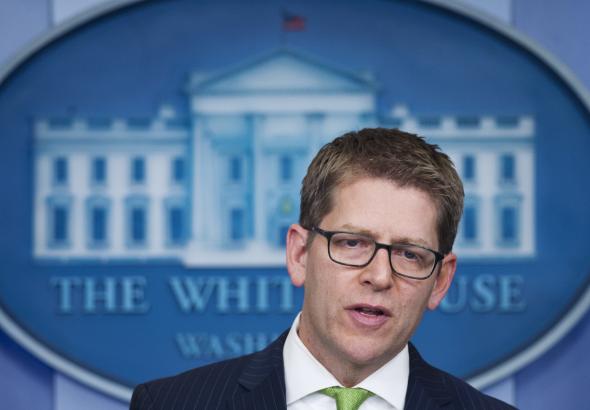The Umpteenth Guide to the Impenetrable Benghazi Outrage

Photo by Mandel Ngan/AFP/Getty Images
It's hard to defend Jay Carney, or the institution of the White House press secretary in general. We're talking about a taxpayer-funded position that exists to feed spin to reporters who are at the top of their field and could be doing literally anything else. The Benghazi Smoking Gun naturally took up a chunk of today's Carney briefing, and ABC News' Jonathan Karl is being celebrated on the right for sticking it to the man and being "vindicated" for previous stories about the White House's talking points role. Carney's excuse—that Ben Rhodes' email about the talking points was not about Benghazi per se, and didn't need to be released—is his typical sort of ridiculousness.
But about those talking points—about the CIA. Karl's insistence that the White House was lying about its role in the "attacks growing out of a demonstration" story is best summed up here.
Q: Ambassador Rice went on those shows, and she said that the attack in Benghazi was rooted in protests over an Internet video. We now know that that was not true, that, in fact, the CIA Director, Morell, just — former Director Morell just testified last month that quote, “when she talked about the video, my reaction was, that’s not something the analysts have attributed this attack to.”
It did not come from the CIA. You stood there at the podium time after time and said that she was referring to talking points created by the CIA. Now we see a document that comes from the White House, not from the CIA, attributing the protests to the video, and we have the former director of the CIA saying that that was not something that his analysts had attributed it to.
MR. CARNEY: Jon, I would point you to what Mike Morell has said repeatedly in testimony about the creation of the talking points.
Q: Well, now we have new talking points, and you didn’t release them — (inaudible) –
MR. CARNEY: Let me finish, please. Jon, I answered that question. The fact of the matter is, there were protests in the region. The talking points cited protests at that facility. The connection between protests and video — and the video turned out not to be the case, but it was based on the best information that we had, and the fact that there were protests –
Q: It was not based on what the CIA was saying, Jay.
And yet it sort of was, wasn't it? Here, in the emails released 11 months ago, is a version of the talking points released by the CIA, to the House Intelligence committee and others, around six hours before Ben Rhodes' email.
The CIA was furthering the talking point that "the attacks in Benghazi were spontaneously inspired by the protests at the US Embassy in Cairo," etc. A later revision added that the agency had warned about social media organizing around a protest. What was the fresh chatter about? The "Innocence of Muslims" video.
So Rhodes repeated the talking point. It's true that Morell subsequently said that he sided with domestic analysts over Libyan analysts—the former said "demonstrations," the latter did not—on Talking Point Day, Sept. 14. It's also true that Morell distanced the CIA from Rice's linkage between the attacks and the "Innocence of Muslims" tape.
Let's look again at what Rice said. On ABC News:
Our current best assessment, based on the information that we have at present, is that, in fact, what this began as, it was a spontaneous -- not a premeditated -- response to what had transpired in Cairo. In Cairo, as you know, a few hours earlier, there was a violent protest that was undertaken in reaction to this very offensive video that was disseminated.
On CBS News:
Based on the best information we have to date, what our assessment is as of the present is in fact what began spontaneously in Benghazi as a reaction to what had transpired some hours earlier in Cairo where, of course, as you know, there was a violent protest outside of our embassy sparked by this hateful video. But soon after that spontaneous protest began outside of our consulate in Benghazi, we believe that it looks like extremist elements, individuals, joined in that-- in that effort with heavy weapons of the sort that are, unfortunately, readily now available in Libya post-revolution.
On NBC News:
Putting together the best information that we have available to us today our current assessment is that what happened in Benghazi was in fact initially a spontaneous reaction to what had just transpired hours before in Cairo, almost a copycat of-- of the demonstrations against our facility in Cairo, which were prompted, of course, by the video. What we think then transpired in Benghazi is that opportunistic extremist elements came to the consulate as this was unfolding.
Rice was saying that protests in Cairo broke out over the video, and that protests in Benghazi copied them. (A month later, the New York Times was reporting that the Benghazi militants were also inspired by the video.) The CIA's talking points referred to "protests" at several embassies, and the Rhodes email added that "these protests are rooted in an Internet video."
Are you lost yet? OK—the entire argument is about Rhodes mentioning, hours after the CIA had suggested the Benghazi attack grew out of demonstrations in several countries, that the immediate inspiration for the demonstrations was a video. That's the scandal—that by giving the video all this credit, the administration was distracting people from the real story that terrorism was surging again. Even though the subsequent 19 months have seen no more attacks on embassies. Even though reporting at the time said the excuse for the protests was said video.
